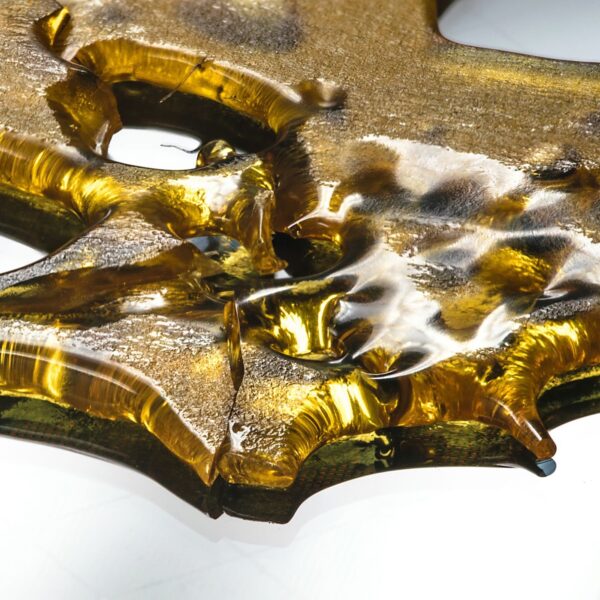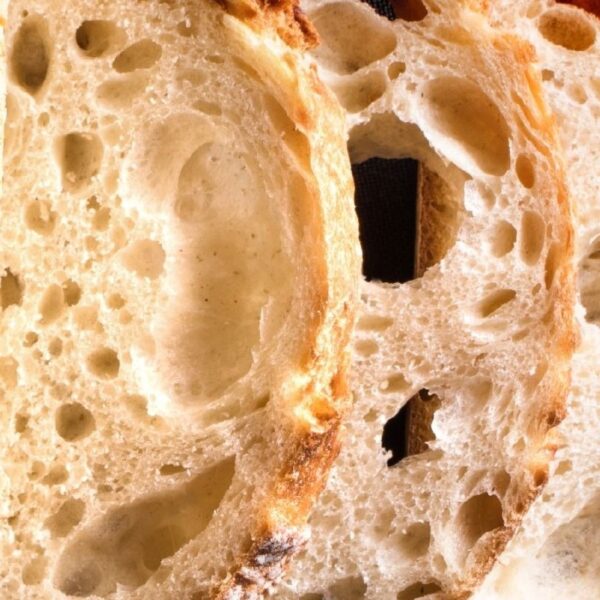Oleic acid is a monounsaturated fatty acid commonly found in various plants and animals. Oleic acid is high in avocados, nuts, and seeds. It also appears in canola, sunflower, olive, and safflower oil. Oleic acid is a source of energy for the body and plays a role in maintaining healthy cell membranes.
What is Oleic Acid?
The chemical structure of oleic acid is a long hydrocarbon chain with a carboxylic acid group at one end. It has a molecular formula of C18H34O2 and a molecular weight of 282.46 g/mol. The hydrocarbon chain of oleic acid consists of 18 carbon atoms with one double bond between carbon atoms 9 and 10. This double bond gives oleic acid its monounsaturated nature. The double bond is in the cis configuration, meaning that the hydrogen atoms attached to the carbon atoms are on the same side of the double bond. The carboxylic acid group at the other end of the molecule is responsible for the acid properties of oleic acid. It can donate a proton (H+) and form salts with bases.

Source: Wikipedia
How is Oleic Acid Produced?
Oleic acid is obtained from various plant and animal sources, primarily through extraction. Oilseeds, such as canola, sunflower, and safflower, are common sources. These oilseeds are crushed and pressed to extract the oil, then refined to separate and purify oleic acid.
Oleic acid is present in animal fats, such as tallow and lard. It constitutes 37-56% of chicken and turkey fat and 44-47% of lard. These fats are obtained from animals through rendering processes, which involve heating the fat to separate it from other tissues. The fat is then further processed to extract oleic acid.
For example, one method involves subjecting a high oleic (60-80% oleic acid) sunflower seed oil to enzymatic hydrolysis within an aqueous medium at 20-60°C. The mixture is agitated so that the oil-water interface and the acid moieties of the triglycerides are separated. An oleic acid layer can form and separate away from the aqueous medium.
Applications in Food and Nutrition
Oleic acid has various uses in food and nutrition due to its beneficial properties. Here are some of its common applications:
| Function | Application |
| Cooking Oil | Oleic acid is a major component of many cooking oils, such as olive oil, canola oil, and sunflower oil. These oils are commonly used for frying, sautéing, and salad dressing. The high oleic acid content in these oils provides a healthy source of monounsaturated fats. |
| Emulsifier & Stabilizer | Oleic acid is used as an emulsifier and stabilizer in various food products, including sauces, dressings, and spreads. Oleic acid as its sodium salt is an emulsifying agent. It helps prevent separation and provides a smooth and creamy texture. It is commonly combined with other co-emulsifiers. |
| Flavor Enhancer | Oleic acid contributes to the flavor of many food products. It adds a mild, fatty taste to foods and enhances the sensory experience. |
Product Examples
| Type | Examples |
| Bakery | Cake, pastries, cookies |
| Snacks | Chips, crisps, popcorn |
| Savory | Mayonnaise, spreads, spreads, margarine |
| Convenience | Energy bars, cereal bars |
| Supplements | Dietary supplements |
Properties of Oleic Acid
| Physical Form | Liquid at room temperature |
| Color | Colorless to yellowish |
| Odor | Odorless or lard-like odor |
| Storage Temperature & Conditions | 2-8°C |
| Molecular Weight | 282.468 g·mol−1 |
| Appearance | Colorless oily liquid |
| pKa | 9.85 |
| Viscosity, 25°C | 26.7 cP |
| Melting Point | 13-14°C |
| Boiling Point | 360°C |
| Acid Value, mgr. KOH/gr | 195-205 |
| Saponification Value mgr. KOH/gr | 197-207 |
| Specific Gravity, 25°C | 0.89 g/mL |
| Solubility | Insoluble in water |
Typical Formulations
Nano-emulsion for essential oil delivery
Here is an example of an emulsion formulation table with oleic acid, along with the % composition of ingredients:
| Ingredient | % Composition |
| DHA (Docosahexaenoic acid) | 30 |
| Olive oil | 1.15 |
| Oleic acid | 1.15 |
| Cremophor RH40 | 22.2 |
| Transcutol-P | 44.4 |
Omega-3 oil exhibits several limitations, including impaired physical- and oxidative stability, low bioavailability, and poor organoleptic properties. The formulation of the self-nano-emulsifying delivery system for omega-3 fatty acids has enhanced bioavailability and improved stability for storage, excellent dispersibility, nanometric mean diameter, and self-emulsification.
Source: Taylor & Francis Online
Bakery Shortening
Here is an example of a bakery shortening fatty acid composition table with oleic acid.
| Ingredient (Fatty acid) | % Composition |
| Myristic acid | 1.59 |
| Palmitic acid | 36.80 |
| Stearic acid | 4.90 |
| Palmitoleic acid | 0.30 |
| Oleic acid | 42.90 |
| Linoleic acid | 12.38 |
| Polyunsaturated fatty acids | 12.38 |
This zero trans-fat crystallized fat formulation is produced by blending palm stearin and high oleic safflower oil. The functional properties and acceptability of oxidative stability are similar to the commercial shortening with trans-fat.
Source: Hindawi
Cookies
Here is an example of a cookie dough formulation table, along with the % composition of ingredients.
| Ingredient | % Composition |
| Wheat flour | 47.8 |
| Sucrose | 20.1 |
| High oleic (77% oleic acid) sunflower oil | 19.1 |
| Corn syrup | 0.7 |
| Skimmed milk powder | 0.5 |
| Ammonium bicarbonate | 0.2 |
| Sodium bicarbonate | 0.5 |
| Water | 10.5 |
| Salt | 0.6 |
Source: NCBI
Coating
Here is an example formulation of an edible coating with oleic acid.
| Ingredient | % Composition |
| Glycerol monostearate | 5.0 |
| Oleic acid | 3.0 |
| Ammonia | 5.0 |
| Glycerol | 0.1 |
| Water | Make up to 100 |
This edible composition was formulated as a coating for fresh harvest products to help prolong shelf life and slow weight loss. Including fatty acid (oleic acid) in the formulation ensures better interaction and uniform dispersion of the formulation on the surface of a fruit or vegetable.
Source: Google Patents
Oleic Acid Formulation Considerations
| Physical Forms | Liquid, semi-solid |
| Stability | – Oleic acid has low thermal stability due to autoxidation at high temperatures. – Oleic acid degradation occurs between 151-285°C. – pH stable – Lipid oxidation of oleic acid easily takes place above 140°C. |
| Nutritional Profile | – Oleic acid adds 9 Cal/g. – Oleic acid is not an essential fatty acid since it can be endogenously synthesized in humans. Stearoyl-CoA desaturase 1 (SCD1) is the enzyme responsible for oleic acid production and, more generally, for synthesizing monounsaturated fatty acids (MUFA). |
| Sensory Attributes | Odorless, colorless with a fatty taste |
| Dosage | 0.5-60% depending upon the application and intended effect |
| Effects on Properties | Nutritional – Oleic acid contributes 9 Cal/g and hence adds to the caloric value of food. – Oleic acid helps absorb fat-soluble vitamins (such as A, D, E, and K) and other nutrients. Sensory – Oleic acid is a liquid at room temperature with a low melting point. Adding to food can help improve the texture by contributing to a smooth and creamy mouthfeel. This is especially beneficial in foods like dressings, sauces, and spreads, where oleic acid can enhance overall creaminess. Functional – Oleic acid is more stable than polyunsaturated fats (such as omega-3 and omega-6 fatty acids) when exposed to high heat. This makes oils high in oleic acid suitable for cooking at higher temperatures without undergoing oxidative damage. – Oleic acid can be used for the preparation of compound food coatings. It can help form a moisture barrier and provide luster. |
| Source | Olive oil, seed (vegetable) oils, avocados, meat, nuts, and seeds |
Safety and Regulatory Considerations
| FDA Information | Oleic acid is a permitted additive for direct addition to food per the US FDA. Intended uses include lubricant, binder, and defoaming agent. |
| EU Information | Oleic acid falls under fatty acids (E570), a permitted food additive. |
Health Effects of Oleic Acid
Oleic acid, a monounsaturated fatty acid, has been associated with several health benefits. Here are a few:
- Heart Health: Oleic acid has been shown to impact heart health positively. It can help lower LDL (harmful) cholesterol levels while increasing HDL (good) cholesterol levels. This can reduce the risk of heart disease and stroke.
- Anti-Inflammatory Effects: Oleic acid has anti-inflammatory properties that can help reduce inflammation. Chronic inflammation is linked to various diseases, including heart disease, diabetes, and certain types of cancer.
- Weight Management: Oleic acid has been found to promote satiety, helping to reduce overeating and manage weight. It can also enhance insulin sensitivity, which benefits individuals with diabetes or those at risk of developing the condition.
- Brain Health: Oleic acid is produced in the brain by neural stem cells. Some studies suggest that diets rich in oleic acid may help improve cognitive function and reduce the risk of neurodegenerative diseases.
- Skin Health: Oleic acid has moisturizing and nourishing properties that can benefit the skin. It helps maintain the skin’s moisture barrier, preventing dryness and promoting softness.
Safety & Toxicity of Oleic Acid
Oleic acid is generally considered safe for consumption and is a naturally occurring fatty acid. It is a common component of the human diet and is well-tolerated by most individuals.
Identification Numbers
| IUPAC Name | (Z)-octadec-9-enoic acid |
| CAS Number | 112-80-1 |
| EC Number | 204-007-1 |
| E Number (Food Additive) | E 570 (Fatty acids) |
| INS No. (Food Additive) | INS 570 (Fatty acids) |
| JECFA Number | 333 |
| FEMA Number | 2815 |
Acceptable Limits or Maximum Usage
The Scientific Committee on Food (SCF) established a group acceptable daily intake (ADI) ‘not specified’ for the fatty acids (myristic, stearic, palmitic, and oleic acid).
Fun Facts About Oleic Acid
- Oleic acid is named after olive oil (Olea europaea), first isolated from this source. Olive oil is particularly rich in oleic acid, and this fatty acid is a major component of its composition.
- Oleic acid is biodegradable, which makes it environmentally friendly. It breaks down naturally over time, reducing its impact on ecosystems.





